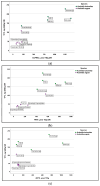Phenolic Compounds in Berries of Winter-Resistant Actinidia arguta Miq. and Actinidia kolomikta Maxim.: Evidence of Antioxidative Activity
- PMID: 38539905
- PMCID: PMC10968433
- DOI: 10.3390/antiox13030372
Phenolic Compounds in Berries of Winter-Resistant Actinidia arguta Miq. and Actinidia kolomikta Maxim.: Evidence of Antioxidative Activity
Abstract
Variations between fruit cultivars can significantly impact their biochemical composition. The present research examined the variability in the qualitative and quantitative content of phenolic compounds in berry extracts of Actinidia kolomikta and Actinidia arguta cultivars. Additionally, antioxidant activities of berry extracts were evaluated. The total phenolic, flavonoid, proanthocyanidin contents and hydroxycinnamic acid derivatives were determined using the appropriate methodologies. The average amount of phenolic compounds in A. kolomikta berries (177.80 mg/g) was three times higher than that of A. arguta (54.45 mg/g). Our findings revealed that berries of A. kolomikta and A. arguta accumulated, on average, 1.58 RE/g DW (rutin equivalent/g dry weight) and 0.615 mg RE/g DW of total flavonoids, 1439.31 mg EE/g DW (epicatechin equivalent/g dry weight) and 439.97 mg EE/g DW of proanthocyanidins, and 23.51 mg CAE/g DW (chlorogenic acid equivalent/g dry weight) and 5.65 mg CAE/g DW of hydroxycinnamic acid derivatives, respectively. The cultivars of both species were characterized by higher antioxidant activity of total phenolic compounds determined using CUPRAC and FRAP methods compared to the ABTS•+ method. The variability in phenolic compounds' qualitative and quantitative content in tested berry extracts was evaluated by applying ultra-high performance liquid chromatography (UHPLC) coupled to mass spectrometry in tandem with electrospray ionization. Significant intraspecific differences in the amounts of total phenolic compounds, total flavonoid compounds, proanthocyanidins, and hydroxycinnamic acid derivatives were determined among cultivars. Four phenolic acids, eight flavonols, two flavones, and five flavon-3-ols were identified in the berry extracts.
Keywords: cultivars; flavan-3-nols; flavones; hydroxycinnamic acid; procyanidins.
Conflict of interest statement
The authors declare no conflicts of interest.
Figures






Similar articles
-
Berries and Leaves of Actinidia kolomikta (Rupr. & Maxim.) Maxim.: A Source of Phenolic Compounds.Plants (Basel). 2022 Jan 6;11(2):147. doi: 10.3390/plants11020147. Plants (Basel). 2022. PMID: 35050034 Free PMC article.
-
Antioxidant and Anti-Inflammatory Effects of Various Cultivars of Kiwi Berry (Actinidia arguta) on Lipopolysaccharide-Stimulated RAW 264.7 Cells.J Microbiol Biotechnol. 2016 Aug 28;26(8):1367-74. doi: 10.4014/jmb.1603.03009. J Microbiol Biotechnol. 2016. PMID: 27160577
-
Anticholinergic effects of Actinidia arguta fruits and their polyphenol content determined by liquid chromatography-photodiode array detector-quadrupole/time of flight-mass spectrometry (LC-MS-PDA-Q/TOF).Food Chem. 2019 Jan 15;271:216-223. doi: 10.1016/j.foodchem.2018.07.084. Epub 2018 Jul 30. Food Chem. 2019. PMID: 30236670
-
Evaluation of antioxidant and antiproliferative properties of three Actinidia (Actinidia kolomikta, Actinidia arguta, Actinidia chinensis) extracts in vitro.Int J Mol Sci. 2012;13(5):5506-5518. doi: 10.3390/ijms13055506. Epub 2012 May 8. Int J Mol Sci. 2012. PMID: 22754311 Free PMC article.
-
Actinidia arguta (Sieb. et Zucc.) Planch. ex Miq.: A Review of Phytochemistry and Pharmacology.Molecules. 2023 Nov 28;28(23):7820. doi: 10.3390/molecules28237820. Molecules. 2023. PMID: 38067549 Free PMC article. Review.
Cited by
-
Biological and Health-Promoting Potential of Fruits from Three Cold-Hardy Actinidia Species.Molecules. 2025 Jan 9;30(2):246. doi: 10.3390/molecules30020246. Molecules. 2025. PMID: 39860116 Free PMC article.
-
Comparison in Antioxidant Potential and Concentrations of Selected Bioactive Ingredients in Fruits of Lesser-Known Species.Foods. 2024 Sep 15;13(18):2926. doi: 10.3390/foods13182926. Foods. 2024. PMID: 39335855 Free PMC article.
-
Genetic Diversity of the Collection of Far Eastern Actinidia spp. Revealed by RAD Sequencing Technology.Plants (Basel). 2024 Dec 24;14(1):7. doi: 10.3390/plants14010007. Plants (Basel). 2024. PMID: 39795267 Free PMC article.
References
-
- Bowen A., Grygorczyk A. Postharvest Handling. Elsevier; Amsterdam, The Netherlands: 2022. Consumer eating habits and perceptions of fresh produce quality; pp. 487–515.
-
- Kupska M., Wasilewski T., Jędrkiewicz R., Gromadzka J., Namieśnik J. Determination of terpene profiles in potential superfruits. Int. J. Food Prop. 2016;19:2726–2738. doi: 10.1080/10942912.2016.1144066. - DOI
-
- Chacha J.S., Ofoedu C.E., Suleiman R.A., Jumbe T.J., Kulwa K.B.M. Future Foods. Elsevier Inc.; Amsterdam, The Netherlands: 2022. Chapter 7—Underutilized fruits: Challenges and constraints for domestication; pp. 133–150. Global Trends, Opportunities, and Sustainability Challenges.
LinkOut - more resources
Full Text Sources
Miscellaneous

